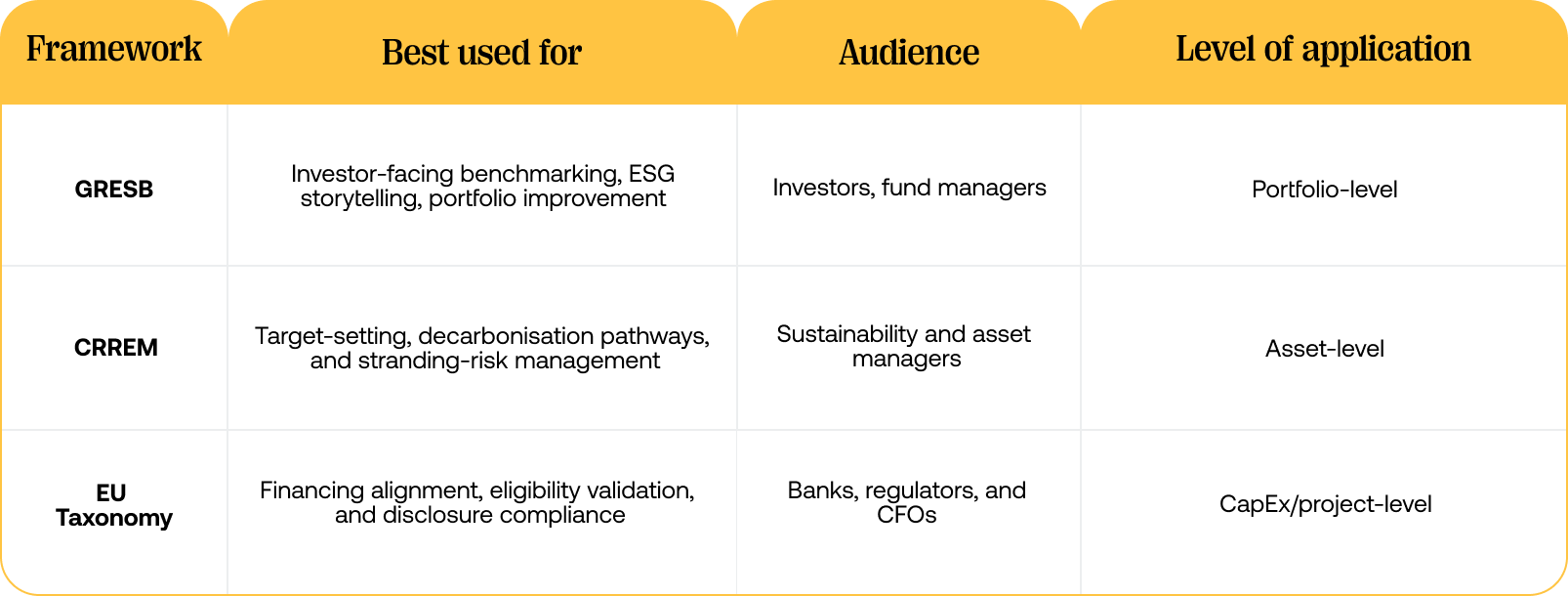GRESB, CRREM, the EU Taxonomy: Which standard should guide your portfolio?

When it comes to sustainable real estate investing and management, standards and frameworks are incredibly important. They essentially guide everything, whether you’re acquiring new assets, offloading, or revamping existing ones.
You’ll hear a lot about three key initiatives: GRESB, CRREM, and the EU Taxonomy. Each has its own logic, strengths, and role to play. Ideally, real estate stakeholders, especially investors and managers, should push for the use of all three standards.
In fact, they’re not really even standards, so to speak. One provides benchmarks, one classifies assets, and one is a tool to bring existing buildings into the sustainability fold. You can probably already guess that each has its own importance, and that’s absolutely right.
The art lies in understanding when and how to use each. This article explores what each framework brings to the table, where they excel, and a practical strategy for weaving them together into a coherent portfolio-level approach.
Let’s get started.
What is GRESB?
The Global Real Estate Sustainability Benchmark (GRESB) is an ESG benchmarking and reporting standard for real assets (real estate and infrastructure). It’s an annual report of member organisations (real estate companies, funds, and portfolios) that compares and monitors sustainability performance across portfolios. And, more importantly, each year, they set benchmarks for members (and non-members) for guidance.
Read our complete guide on GRESB.
The GRESB Real Estate Assessment is structured across components like Management, Performance, and (for development portfolios) Development. Participants receive benchmark scores, peer comparisons, and a roadmap of ESG improvements. Institutional investors use the results to screen and engage managers.
Keep in mind that GRESB isn’t a regulatory thing. However, it's closely tied to disclosure regimes: for example, it incorporates EU Taxonomy (more on that later) calculations and helps participants with SFDR (Sustainable Finance Disclosure Regulation) reporting.
What is CRREM?
CRREM (Carbon Risk Real Estate Monitor) is a carbon-risk framework made for real estate, especially in Europe. It focuses specifically on decarbonisation trajectories, stranding risk, and pathway analysis.
CRREM was funded in part by the EU Horizon 2020 programme and is designed to translate global climate goals (1.5°C/2°C) into building-level energy/carbon intensity pathways. It assigns target trajectories (for energy use, GHG emissions per square metre) for different building types, countries, and vintages. In simple words, it provides an asset-level assessment of whether a building is “on track” or at risk of being stranded, in terms of sustainable performance.
What is the EU taxonomy?
The EU Taxonomy is a regulatory classification system intended to define what economic activities can be considered environmentally sustainable. It’s part of the EU’s Green Deal and is designed to help the EU reach its objectives and goals for carbon neutrality and eventually net-zero emissions. In real estate, it offers objective criteria to assess whether a property or activity is “green” according to the EU’s climate goals.
To count as taxonomy-aligned, an activity must:
(a) Substantially contribute to one or more environmental objectives (e.g., climate mitigation or adaptation)
(b) Do no significant harm (DNSH) to any other environmental objective
(c) Comply with minimum social safeguards.
For buildings/real estate, eligibility and alignment depend on metrics such as energy performance thresholds, emissions intensity, renovation criteria, and life cycle considerations.
The EU Taxonomy is increasingly being used for sustainable financing. It also influences the Corporate Sustainability Reporting Directive (CSRD).
What is each best at (in a real estate portfolio context)
GRESB, CRREM, and the EU Taxonomy are essentially three different frameworks, with one major overlap – they’re instrumental in making real estate portfolios more sustainable. With these, you can improve the environmental performance of assets through energy, water, and waste management, among other initiatives.
Here’s a quick guide on what each of these frameworks excels at and who it’s meant for:

For most stakeholders, but particularly those financing real estate projects, it should make sense to use all three at some point. However, there are instances where a particular framework makes more sense. For example, if you have an asset that’s far behind industry benchmarks in sustainable performance, CRREM should be your go-to.
For newer projects, for example, both GRESB benchmarks and EU Taxonomy classifications can be useful.
Which one to use and when?
In practice, real estate portfolios should not pick one standard to “rule them all.” Instead, you need a layered strategy, ideally according to the needs of individual assets within the portfolio. After all, a diverse portfolio might have properties at different levels of environmental competency.
Here’s a playbook by priority or use case.
Investor signalling priority (for property owners and managers)
When the goal is to signal ESG credentials to investors, capital allocators, or external stakeholders:
- Start with GRESB. A strong GRESB score (or year-on-year improvement) is visible, comparable, and may even be required by institutional investors
- Then layer in CRREM pathways. Use decarbonisation trajectories as a back-end justification for how your portfolio will progress behind the score. This helps address questions from sophisticated (climate-aware) investors who want real solutions
Stranding-risk and retrofit focus (for both investors and managers)
If your primary concern is identifying assets that might become stranded or underperform due to tightening regulations or energy market stress, consider CRREM. As mentioned earlier, it can pinpoint which assets are off-path and quantify how far off-path they are.
Simultaneously, ensure that data fields are “taxonomy-ready” from day one (e.g., building-level energy intensity, emissions factors, age/durability, renovation timings). This ensures that as you retrofit or reposition, those upgrades are compatible with future regulatory compliance. In essence, this approach is data-first and risk-averse.
Financing priority
If your immediate priority is securing green finance, loans, or bonds, or satisfying eligibility thresholds for certain funds:
- Lead with EU Taxonomy alignment. Demonstrating that your activities are taxonomy-aligned gives you access to “green” labels, favourable financing terms, or compliance status
- Once aligned, report outcomes via GRESB. You can become a member or compare your assets’ performance with the publicly available most current benchmark
Where does data come into all of this?
Data is the common denominator when it comes to GRESB, CRREM, and the EU Taxonomy. Each of them, in their own right, requires detailed, granular data of the asset in question.
Let’s take CRREM as an example and see how data enables it to do what it does.
CRREM works by comparing your building’s actual performance in terms of energy intensity (kWh/m²) and carbon intensity (kgCO₂e/m²) to science-based decarbonisation pathways that are specific to the building’s country, asset type, and year of construction.
Suppose you manage a 20,000 m² office building in Amsterdam, built in 2008.
- Your utility data shows an annual energy consumption of 3,800,000 kWh
- This equals 190 kWh/m² per year
- Using Dutch grid factors (approx. 0.29 kg CO₂/kWh in 2024), your carbon intensity is roughly 55 kg CO₂/m²
CRREM’s 1.5°C pathway for Dutch offices may set the target for 2025 at around 40 kg CO₂/m², and 25 kg CO₂/m² by 2030. That means your building is already off-path by about 37%, and would be “stranded” by 2027 if no retrofit or decarbonisation action is taken. You see where we’re going with this?
Data is what powers sustainability frameworks. It’s what helps you understand the EU Taxonomy requirements.
Pro-tips for using data (and mistakes to avoid)
- Find asset-level energy and emissions data (electricity, heating, cooling, fuel, refrigerants) mapped to floor area and normalised intensities
- Use historical consumption time series, weather normalisation, and occupancy data
- Track capital expenditure (capex) and operational expenditure (opex) on energy or sustainability upgrades
- Keep detailed building metadata (year built, envelope, HVAC systems, renovation history), which can be useful in setting realistic baselines.
- Maintain regulatory context, emissions factors, and grid intensity data (where available).
- Benchmark and peer data to calibrate assumptions (e.g., industry decarbonisation curves)
- Invest in data integration tools and ESG platforms to automate collection, validation, and alignment (versus manual spreadsheets).
And as you do all of this, watch out for the many pitfalls that arise when data is missing, inconsistent, or lacking traceability. Without good data, you risk misreporting, greenwashing, or underestimating risks.
One dataset, three lenses
GRESB, CRREM, and the EU Taxonomy each offer indispensable but distinct ways to view portfolio performance, risk, and eligibility. GRESB functions as your ESG scoreboard, CRREM is your technical decarbonisation roadmap and risk detector, and the EU Taxonomy acts as the regulatory gatekeeper for green financing.
Your use of each may depend on current goals and circumstances. However, at the heart of all of this is data. Since energy usage is a major driver of the environmental performance of buildings, it’s one of the first things you’d want sorted.
comundo has been a game-changer for real estate portfolios with its no-nonsense, factual, and accurate energy data reporting, down to individual assets (and sometimes even units in those assets).
It’s this correct and relevant energy data that can help you compare performance with GRESB benchmarks or use CRREM to calculate the risk of stranding. Data, and even more so, energy data, is the key to making the best of frameworks, standards, and more pathways to a green future.

